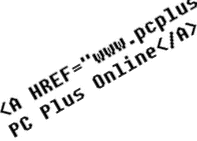A WYSIWYG editor is still the best way to create basic page layouts, but an understanding of HTML can be very useful when you're fine-tuning and debugging your pages. After two years of picking up HTML skills on a tag-by-tag basis, I've decided it's time to get a proper grasp of HTML fundamentals. Paul Stephens
|
 HTML can be hard for programmers to grasp, because it's not a
programming language. Instead its roots lie in early word processing technology, when
documents contained plain text interspersed with 'markup tags' indicating how the text
should be formatted. HyperText Markup Language (HTML) works on the same principles, the
main difference being that it adds new technology such as images and hyperlinks. HTML can be hard for programmers to grasp, because it's not a
programming language. Instead its roots lie in early word processing technology, when
documents contained plain text interspersed with 'markup tags' indicating how the text
should be formatted. HyperText Markup Language (HTML) works on the same principles, the
main difference being that it adds new technology such as images and hyperlinks.
This month, check out an 8-step example guide, covering the text, markup tags and tag attributes, the essential HTML document template, and the two most important tags - images and hyperlinks. I haven't attempted to give a detailed reference to the tags and their attributes, partly because there's too much to include, but mainly because it's already been done in really excellent fashion by Microsoft in its Internet Client SDK (note the new address) and, only a bit less excellently, in Netscape's HTML Tag Reference .It's worth downloading both these free, HTML-based resources and keeping them on your PC for instant reference. Until next month, happy authoring! |